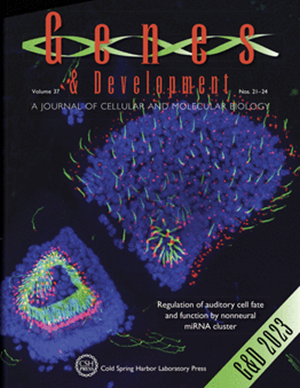活性端粒延长与癌症相关的POT1突变亚类
IF 7.7
1区 生物学
Q1 CELL BIOLOGY
引用次数: 0
摘要
庇护蛋白POT1的突变与多种癌症有关,并被认为通过破坏POT1对异常端粒伸长的抑制来驱动癌变。为了分类临床不确定意义变异(VUSs)并识别癌症驱动的功能丧失突变,我们开发了一个局部单倍人类干细胞系统来评估1900个POT1突变,其中包括600个VUSs。出乎意料的是,许多证实的家族性癌症相关的POT1 (caPOT1)突变对于细胞活力是单倍足的,这表明一些致病性等位基因不通过功能丧失机制起作用。相反,POT1的DNA损伤反应抑制和端粒长度控制在遗传上是可分离的。ATR抑制使移码突变体得以分离,这表明POT1的唯一基本功能是抑制ATR。此外,caPOT1和移码等位基因的比较揭示了一类caPOT1突变比完全丧失功能的等位基因更快地延长端粒。这种促进端粒长度的活性独立于POT1在悬垂固存和填充合成中的作用。本文章由计算机程序翻译,如有差异,请以英文原文为准。
Active telomere elongation by a subclass of cancer-associated POT1 mutations
Mutations in the shelterin protein POT1 are associated with diverse cancers and thought to drive carcinogenesis by impairing POT1's suppression of aberrant telomere elongation. To classify clinical variants of uncertain significance (VUSs) and identify cancer-driving loss-of-function mutations, we developed a locally haploid human stem cell system to evaluate >1900 POT1 mutations, including >600 VUSs. Unexpectedly, many validated familial cancer-associated POT1 (caPOT1) mutations are haplosufficient for cellular viability, indicating that some pathogenic alleles do not act through a loss-of-function mechanism. Instead, POT1's DNA damage response suppression and telomere length control are genetically separable. ATR inhibition enables isolation of frameshift mutants, demonstrating that the only essential function of POT1 is to repress ATR. Furthermore, comparison of caPOT1 and frameshift alleles reveals a class of caPOT1 mutations that elongate telomeres more rapidly than full loss-of-function alleles. This telomere length-promoting activity is independent from POT1's role in overhang sequestration and fill-in synthesis.
求助全文
通过发布文献求助,成功后即可免费获取论文全文。
去求助
来源期刊

Genes & development
生物-发育生物学
CiteScore
17.50
自引率
1.90%
发文量
71
审稿时长
3-6 weeks
期刊介绍:
Genes & Development is a research journal published in association with The Genetics Society. It publishes high-quality research papers in the areas of molecular biology, molecular genetics, and related fields. The journal features various research formats including Research papers, short Research Communications, and Resource/Methodology papers.
Genes & Development has gained recognition and is considered as one of the Top Five Research Journals in the field of Molecular Biology and Genetics. It has an impressive Impact Factor of 12.89. The journal is ranked #2 among Developmental Biology research journals, #5 in Genetics and Heredity, and is among the Top 20 in Cell Biology (according to ISI Journal Citation Reports®, 2021).
 求助内容:
求助内容: 应助结果提醒方式:
应助结果提醒方式:


